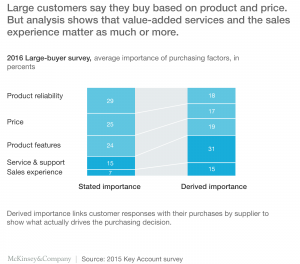Long gone are the days when European companies had a monopoly over quality products and accessible services. The new manufacturing competitors from lower-cost production countries produce good enough products for European end-customers. Online marketplaces invest in B2B service development to disrupt B2B markets just like they have disrupted B2C markets. How to ensure that European companies continue delivering value that justifies owning the customer relationship?
This is the first post of the two-piece series about competitiveness of European B2B manufacturers and distributors. In this post, I explore structural and cultural issues that hinder unlocking future competitive advantages. The second post is about playing with the idea of Open B2B Industry and evaluating if it is a feasible future scenario.
The focus of this post is the competitive environment and winning in Europe. The views are based on our experience working with manufacturers and distributors offering B2B products in categories where the quality of pre-sales, sales and delivery, after-sales as well as the responsiveness and professionalism of the service can have a significant impact on the financial outcome of the end-customer.
Responsive customer service matters more than ever
In our view, differentiation through seamless customer journeys and fast customer-centric services – having the right product, having it timely delivered and being attentively supported while using it – is the key future opportunity for European B2B businesses. The challenge is that the seamless services can only be achieved by deeper collaboration within the value chain. Long traditions, the legacy structures, long-standing relationships as well as established roles between manufacturers and distributors make it difficult for companies to adjust their business models to the disruptive changes in market conditions and customer expectations.
The distributor relationship: Justifying value beyond the product
A manufacturer has two distinct customer groups: distribution partners and end-customers. From the distributor’s perspective, a preferred manufacturer produces desirable, reliable and easy to sell products that sell in high volumes and deliver high margins. The manufacturer should make the product available with minimum hassle and maximum support, ranging from marketing support to sales training, thus reducing the operational cost of the distributor.
Even if these extras cost money for the manufacturers, they often are considered as part of the deal and left unquantified in annual agreements, leaving the manufacturer vulnerable to low-cost competition. Despite their versatile offerings and high service levels, made possible by their local market presence and KAM organisations, quality manufacturers end up competing with their low-cost competitors on the product price alone.
The lower wholesale prices of the good enough products make it tempting for distributors to introduce distributor-branded white label products. These white label products work as a powerful bargaining chip in annual negotiations for lower prices with the quality manufacturers.
Are product and price the only purchase drivers for experienced buyers? According to McKinsey, service and support is the most important buying factor, twice as important as price. Large businesses have complex supply chains, specific production needs, and demanding downstream customers. For this reason, finding the right supplier partners should be more important than getting the lowest price. The insight is based on a McKinsey survey of more than 1,000 large buyers across industries.

Even with the support of this evidence, to redefine the DNA of the partnership and shift the focus from price to value that goes beyond the product is a tough task. It takes a long-term commitment to master value-based selling tactics to justify the premium price or to commercialise ancillary services for new revenue streams.
The end-customer relationship: Focus on new digital services
To maintain volumes and market share in an increasingly commoditised market, many quality manufacturers adjust their operations to lower margin levels and shift their focus from product innovation to operational efficiency. Even if the operational efficiency is a prerequisite for profits in the digital age, it does not transform the business to meet the changes in market conditions.
As the direct-to-customer sales model is costly and risky and, therefore, not the most feasible option, the manufacturers invest in new digital service platforms to build a pre- and after-sales relationship with the end-customer. The thinking goes if we cannot own the customer database for the actual purchases; at least we can better control the end-customer market with the customer data that is stored in the configuration and warranty databases.
Inside-out approach leads to competing and fragmented customer journeys
At the same time, the distributors invest in new digital services to strengthen their market position against global e-commerce brands. Does all this digital service innovation lead to better customer experience? Unfortunately, the answer is no. The inside-out planning approach and the lack of co-operation lead to fragmented customer experience.
In the digital environment, end-customers sign-in for complete customer journeys, not for isolated services. They also sign-in for better and faster, not worse, experiences. In many B2B product categories, the local knowledge provided by local KAM organisations play an essential role in identifying a suitable solution. The project teams of digital service platforms often make little effort in integrating the local human service onto the new platforms, leading the new digital services missing what the European brands are known for: having local presence and the best local knowledge. As digitalisation often means anti-localisation, the ROI of digital investments remains low, and product sales suffer.
The paradox: Non-threatening projects do not protect from external threats
The European manufacturers and distributors share a history of aligning their business operations on the supply chain side for greater operational efficiencies with enterprise resource planning (ERP) integrations, an automated Available-to-promise (ATP) function, digital documents and electronic data interchanges (EDI) as well as automated confirmations and notifications. Back-end innovation for higher productivity, even if it means integrating systems and exchanging data real-time, is a rational and non-threatening thing to do.
The paradox is that the non-threatening back-end projects do not protect businesses from external threats. The front-end business alignment does that. The good news is that business partners can now build on their past experiences as both front-end and back-end alignment are needed to create seamless customer experiences. After all, the key benefits of back-end alignment, greater transparency in product availability and deliveries, play a key role in the customer experience of the end-customer.
Where to start?
Whether you are a manufacturer or a distributor, the first step is to challenge the current, deep-rooted structures and practices that came into being during the non-global and non-digital era. The second step is to engage your business partners in an open discussion about the business challenges you both face, although from different angles, and play with the idea of a different future. Easier said than done. Can you afford not to try it?

About the author


